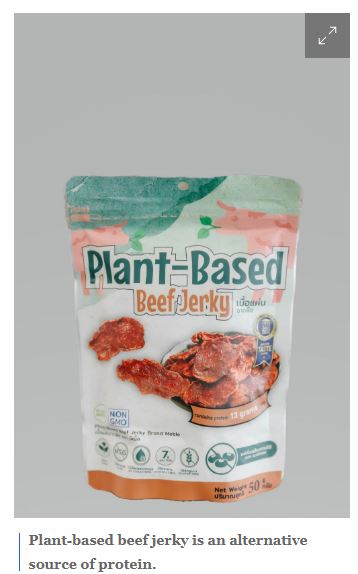Thailand: Food industry looks to the future
Thailand’s future food industry is projected to grow 5% this year, driven by emerging trends and increasing demand for healthier and more environmentally friendly food options.
According to Visit Limlurcha, president of the Thai Future Food Trade Association, there are ample opportunities for exports because of global trends, leading to significant changes in production, economies, lifestyle, society and behaviour.
Between 2016 and 2022, the Thai future food sector averaged 7% annual growth, with industry value rising from US$2.5 billion to $3.73 billion, accounting for 9% of all food exports last year.
 HIGH BASE LAST YEAR
HIGH BASE LAST YEAR
The association aims for 5% growth in Thai future food exports this year, thanks to a relatively high base established last year.
The value of $3.73 billion, a surge of 12% from 2021, was fuelled by heightened demand for food security and increased awareness of health concerns among consumers in both domestic and international markets, following the pandemic.
Mr Visit said the association is focusing more on the domestic market this year and launched a campaign to raise awareness about future food.
The campaign, called “Wen Day on Wednesday”, invites Thai consumers, restaurants, canteens, schools, hotels and hospitals to offer future foods every Wednesday.
The campaign draws inspiration from initiatives such as Meatless Monday in the US, which encourages people to consume less meat.
In Thailand, each day of the week is associated with a specific colour, and Wednesday’s colour is green, which the association said symbolises health, freshness and sustainability.
The term “wen” in Thai means “avoid or skip”, emphasising the idea of trying future food once a week instead of a typical meal.
The campaign suggests avoiding certain items on Wednesdays, such as large animals, exploring alternative options made from plants, mushrooms, fermented foods or insects.
The campaign also promotes organically grown foods as an alternative to agrochemicals, functional foods for various bodily functions instead of medicines, and medical foods for home consumption.
Future food encompasses four categories: functional food, novel food, organic food and medical food.
The Wen Day on Wednesday campaign has garnered the participation of 21 food manufacturers that offer promotions that day, such as price reductions.
This initiative is one of many the association is using to drive the growth of the industry, focusing on enhancing food safety, food security and holistic development, said Mr Visit.
In overseas markets, Thai Trade Centers will help introduce Thai future food products to foreign customers at trade events, he said.
 HEALTH TREND
HEALTH TREND
Health is a major trend affecting the food industry, as the pandemic made people more aware of their health, leading to a preference for healthy food, exercises for rehabilitation, and a focus on hygiene and safety to prevent both communicable and non-communicable diseases.
In response to this trend, food operators have improved their formulations, changed their products, and developed new offerings to meet consumer demand, said the association.
TECHNOLOGY
Another trend influencing the food industry is technology. Innovative food products continuously enter the global market, often using advanced technologies to support their expansion.
Some of the technologies used in the industry include: bioengineering, synthetic biology, genetic modification, nanotechnology, artificial intelligence, big data management, blockchain, robotics, augmented reality, mixed reality and virtual reality.
Any of these could play a significant role in shaping the future of the food industry, according to the association.
 DEMOGRAPHIC STRUCTURE
DEMOGRAPHIC STRUCTURE
While the global population continues to increase, variations in fertility rates lead to diverse demographic structures, affecting food demand and differing rates of consumption across several age groups, said Mr Visit.
Factors such as nationality, society, religion, culture, urbanisation and immigration also influence consumption patterns, according to the association.
These diverse factors contribute to the multiplication of trade requirements, standards and regulations that food operators must comply with, leading to increased production costs, he said.
CLIMATE CHANGE
Environmental concerns have garnered global attention, particularly because of the impact of climate change, which has resulted in more frequent and severe natural disasters, loss of property, disrupted ecosystems and food insecurity.
As a result, consumers are increasingly aware of the importance of sustainable sourcing and responsible production methods, said Mr Visit.
Food entrepreneurs must enhance their production and supply chains in accordance with the bio-, circular and green economic model to ensure their products align with market demand, he said.
VIGILANCE NEEDED
The food industry must accelerate efforts to add value to their products, ensuring reliability, enhancing food security, and fostering fair trade competition to meet the UN Sustainable Development Goals, said Mr Visit.
To keep pace with these trends, food producers need to improve their production planning and supply chain management, reducing food waste at all stages of processing, optimising productivity, and minimising energy and resource consumption.
“Addressing the challenges posed by these global trends requires a comprehensive understanding of how to redesign our food system to promote health, sustainability, resilience to climate change, and alignment with new world demands,” he said.
“Food producers must also remain attentive to geographical conflicts and economic recessions. Since some food raw materials rely on imports, political conflicts may lead to shortages of essential ingredients. Economic recessions can affect customers’ purchasing power overseas.
“These factors necessitate vigilance and adaptability from food operators to mitigate potential disruptions caused by declining consumer demand.”
Source: https://www.bangkokpost.com/business/2585881/food-industry-looks-to-the-future


 English
English




